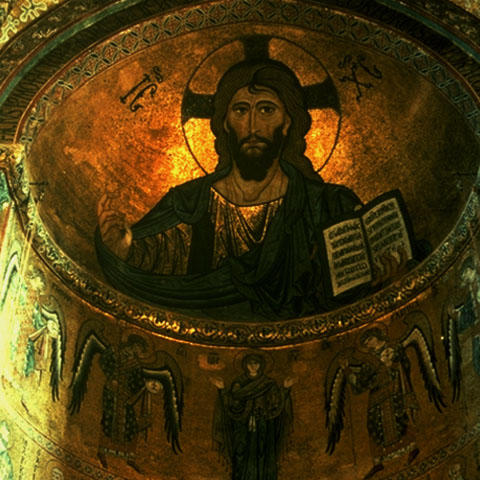
The Eastern and Oriental Orthodox churches are rooted in Greece, the Middle East, North Africa, and India. These churches are theologically and liturgically distinct from those in the Roman Catholic and Protestant traditions, and have weathered centuries of challenge and change.
View full album
The Orthodox family of churches, today called the Oriental Orthodox and Eastern Orthodox churches, date back to the very earliest days of Christianity. During the first four centuries of the Common Era, Christianity had spread not only into the Roman and Byzantine Empires, but also into the present-day Middle East, North Africa, and India. Christians were united through a pentarchy of patriarchal leaders in Antioch, Alexandria, Constantinople, Jerusalem, and Rome.
Following the Council of Chalcedon in 451 CE, however, Christological controversies opened new fissures in the Church. The council aimed to clarify that Christ’s human and divine natures were indivisibly united in him. Nestorius, the Patriarch of Constantanople, however, had taught that such doctrines created confusion between the human and divine. Nestorius was deposed and Constantinople remained in communion with Rome, but other Christians also rejected the Chalcedonian formulations, either because they minimized the differences between Christ’s two natures or diminished their unity. Christians of Egypt, Ethiopia, Syria, Armenia, India, Iraq, and Iran either formally followed their leaders into schism or quietly fell away from the Greco-Roman community due to vast distances and difficult terrain. Many of these communities would later become known as the Oriental Orthodox churches.
In the centuries that followed, growing estrangement between the western hierarchy under the Pope in Rome and the eastern hierarchy based in Constantinople eventually led to the “Great Schism” of 1054 CE, when a delegation of Roman Cardinals and the Patriarch of Constantinople excommunicated one another. The causes were as much political as theological, ranging from the role of the Holy Spirit in the Trinity to the authority of the Pope. The divorce took centuries to complete, but the resulting institutions became known respectively as the Roman Catholic Church and the Eastern Orthodox churches.
The distinctive theologies and liturgies of the Oriental and Eastern Orthodox churches have continued to develop into the 21st century. One particularly characteristic theological stance, for example, is the Orthodox emphasis upon the incarnation of Christ as a means to raise human nature to the Divine. As Athanasius put it in the 4th century, “the Son of God became man so that man might become God.” This focus on theosis, “becoming divine,” stands in contrast to the heavy emphasis on human sinfulness present in much of the theology of the Western churches.
Monasticism was also an important part of the early church tradition, as devout men and women left urban life and the growing institutions of the church for a life of devotion to God in prayer and simplicity. Monastic life began as early as the 3rd century, with St. Anthony and the Desert Fathers of Egypt, in whom both Eastern and Western monastic traditions find their source and inspiration. As Eastern monasticism developed, it included forms of both communal and solitary religious life and emphasized physical austerity. From these early centuries onward, the Eastern traditions also developed practices of inner contemplative prayer called the “Jesus prayer” and the “prayer of the heart.” These forms of concentration and breath-centered prayer have been preserved in the church to the present day.
As part of their rich spiritual and liturgical traditions, the Orthodox churches also developed the distinctive use of visual icons of Christ, the Virgin Mary, and the saints. These icons were understood to be windows into the sacred meaning and presence of these figures, not mere representations of them. The second council of Nicaea in 787 CE affirmed the role of icons in the face of virulent criticism from those who objected to any visual images in worship.
During the 7th century, Christianity encountered Islam, a new religious tradition which gained ground in Palestine, Syria, and Egypt, and from Anatolia to Spain. The great Dome of the Rock mosque was completed in Jerusalem in 692 CE. Eight centuries later in 1453, the capital of the Byzantine Empire, Constantinople, fell to the Ottoman Turks. Thus the great centers of Orthodox Christianity became centers of Islamic rule, and many churches became mosques. For hundreds of years, Islam has been a significant and immediate presence for Oriental Orthodox and Eastern Orthodox churches.
Today, the Eastern Orthodox churches constitute a family of related churches, including the Greek, Russian, Bulgarian, Romanian, and Syrian churches, each with a rich history and distinctive liturgical forms. The Oriental Orthodox churches include the Armenian Apostolic Church, the Coptic Church of Egypt, the Ethiopian Church, the Eritrean Church, the Church of St. Thomas in India, and the Jacobite Syrian Church of Antioch. In 2001, a council of bishops representing both the Eastern Orthodox and the Oriental Orthodox churches declared their Christologies effectively consistent, citing linguistic and political factors for their historical disagreements. While the Eastern Orthodox and Oriental churches are not yet in full communion, they, like the Eastern Catholic churches—those who are in communion with Rome but who follow Eastern traditions of worship—share very similar theology and practices. As reconciliation efforts continue today in the early 21st century, the religious landscape of America includes the presence of most of the churches of the Oriental Orthodox and Eastern Orthodox family.